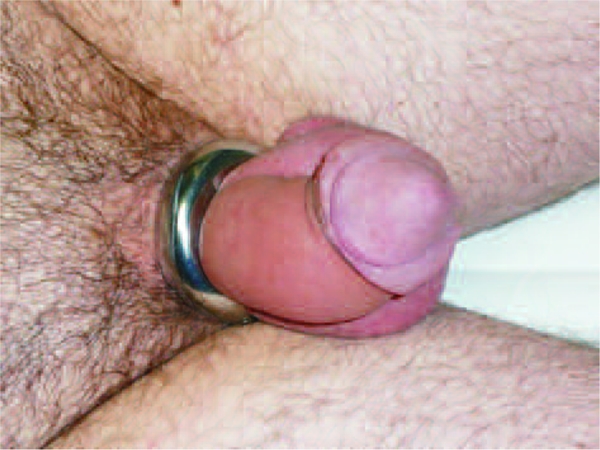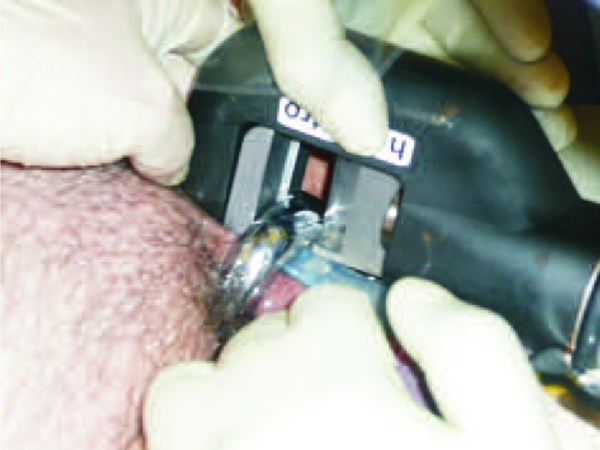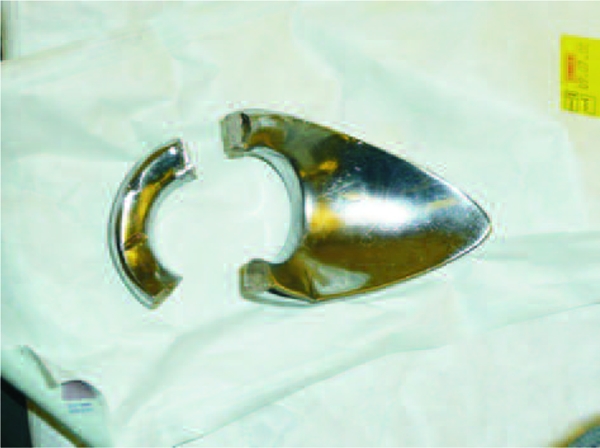Abstract
The incidence of metallic rings causing genitalia strangulation has been widely reported. The removal of the constricting rings can be challenging and might need resources not usually available in the hospital.We report one such case where the assistance of a fire crew was required to remove the ring.
Keywords: Genitalia strangulation, Metallic ring, Pedal cutter
Case report
A 50-year-old man presented to the emergency department with a grossly swollen penis and scrotum. He had used a metallic ring for enhancement of his sexual performance 2-days previously. The ring was stuck at the root of his scrotum, causing oedema of the penis and scrotum (Fig. 1). The ring could not be removed because of the swelling of the genitalia. There was no difficulty in passing urine and there was no damage to the underlying skin. Attempts to remove it with the ring cutter and orthopaedic saw were unsuccessful due to the sheer thickness of the ring, which was about 2-cm thick.We had to contact the fire department who proposed using the ‘Pedal Cutter’. The patient refused to have general anaesthesia. With great care and much lubrication using Lignocaine gel, malleable retractors were passed under the ring to protect the skin. The pedal cutter, operated by the fire crew, was applied and, with the surgeon taking care of the genitalia skin (Fig. 2), the ring was removed by cutting it in two places (Fig. 3). There was no damage to the underlying skin. The patient went home within the hour after removal of the ring.
Figure 1.

Metallic ring causing oedema of the penis and scrotum.
Figure 2.

Positioning the pedal cutter.
Figure 3.

Ring cut in two places after removal.
Discussion
Penile incarceration has been reported in a wide spectrum of age groups, with the incarcerating object most frequently placed for erotic or auto-erotic purposes or by psychiatric patients. The ring is inserted when the penis is flaccid and it becomes irremovable after erection. Subsequently, due to oedema, it strangulates the genitalia. Delay in removing the constriction can cause tissue loss.1 Removal should ideally take place under general anaesthesia and extreme care should be taken to avoid any iatrogenic injury to the genitalia. Removal may require instruments not available in the theatre, as in this case. Removal of such devices can be challenging and often requires resourcefulness and a multidisciplinary approach. Pedal cutters are specialised instruments only to be used by trained operators. Pedal cutters are designed to cut through metal in locations where access is restricted, such as vehicle pedals, steering wheel spoke, etc. During cutting operations, the blades should remain as close to right angles to the material as possible; should the blades twist, they should be opened immediately and the process re-started.
Each case needs individual handling in removing the object and the choice of method depends upon type, size, incarceration time, injury grade, and availability of equipment. Different methods are cited in the literature.1–5 We found the pedal cutter to be a safe alternative provided all the safety precautions are observed.
Conclusions
Penile incarceration is an emergency with potentially severe clinical consequences. With rapid intervention and removal of the foreign body, patients do extremely well and need no further intervention. Treatment can require a multidisciplinary approach and, often, help from nonmedical departments.
Acknowledgments
The authors are grateful to the Bedfordshire and Luton Fire and Rescue Service for its assistance.
References
- 1.Ivanovski O, Stankov O, Kuzmanoski M, Banev S, Filipovski V, et al. Penile strangulation: two case reports and review of the literature. J Sex Med. 2007;4:1775–80. doi: 10.1111/j.1743-6109.2007.00601.x. [DOI] [PubMed] [Google Scholar]
- 2.Patel C, Kim R, Delterzo M, Wang R. Prolonged penile strangulation with metal clamps. Asian J Androl. 2006;8:105–6. doi: 10.1111/j.1745-7262.2006.00078.x. [DOI] [PubMed] [Google Scholar]
- 3.Bhat AL, Kumar A, Mathur SC, Gangwal KC. Penile strangulation. Br J Urol. 1991;68:618–21. doi: 10.1111/j.1464-410x.1991.tb15426.x. [DOI] [PubMed] [Google Scholar]
- 4.McLaughlin T, Coyner W. Removal of a strangulating metal bearing from the penis. J Urol. 1989;141:617. doi: 10.1016/s0022-5347(17)40915-3. [DOI] [PubMed] [Google Scholar]
- 5.Buckner BJ, Parousis V, Tarry W, Zaslau S. Strangulation injuries of the glans penis: a case series. W V Med J. 2004;100:187–8. [PubMed] [Google Scholar]


